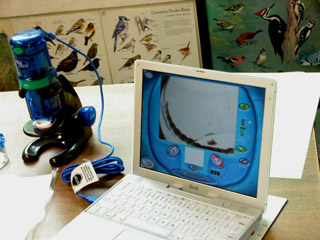Water Quality: Examining Living Organisms—Activity Sheet
 Most of the life-forms in freshwater and salt water are microscopic. Use the microscope to magnify the water samples for observation.
Most of the life-forms in freshwater and salt water are microscopic. Use the microscope to magnify the water samples for observation.
Observe water with the naked eye
Note the presence of plants or visible aquatic organisms with the naked eye and examine under a hand-held magnifying glass. What does the water look like? Record what you see and tally the population of your sample. Be as descriptive as you can. Drawings can be very useful.
Prepare slides for each of the water samples
Prepare slides for the microscope to view the micro-invertebrates in the water. Using an eyedropper, put a few drops of your water sample on a depression slide. Holding a cover slip at an angle, slowly allow the cover to slide over the water and seal the water sample to the slide. If there are small air bubbles in the sample, repeat the process again. Cover slips are necessary to keep the sample from moving and to protect the lens of the microscope from water damage.
Examine the slides under the microscope

![]() Focus: To focus an image of a specimen, set the power selection wheel to 60X and slowly turn the focus knob until image is clear. Carefully move the specimen so that the desired area of the specimen for exploration is in the center of the View Screen.
Focus: To focus an image of a specimen, set the power selection wheel to 60X and slowly turn the focus knob until image is clear. Carefully move the specimen so that the desired area of the specimen for exploration is in the center of the View Screen.![]() Lighting: Using either a top or a bottom light to illuminate the stage will increase the clarity of the image.
Lighting: Using either a top or a bottom light to illuminate the stage will increase the clarity of the image.![]() Capture Images: Remember to capture images to include in your project report. The microscope allows you to export captured images for use in Word documents, presentations, or Web pages.
Capture Images: Remember to capture images to include in your project report. The microscope allows you to export captured images for use in Word documents, presentations, or Web pages.
Identifying microscopic invertebrates
he presence or absence of certain types of algae and diatoms is associated with certain water conditions. Can you use the micro-invertebrates chart to identify organisms in the water to determine the quality of the water? Note that the healthiest pond water has a tremendous amount of biodiversity, whereas the healthiest drinking water has no living organisms. 
Identifying macro-invertebrates
Observe your macro-invertebrates sample with the naked eye. Note how they move, how they breathe, and how they interact with each other. What are their body adaptations for living in the sample area? Record what you see and tally the population of your sample. Certain types of invertebrates are associated with certain levels of health in waterways. For the larger or macro-invertebrates, use the macro-invertebrates questionnaire to identify the species in your sample to determine water quality. Higher levels of oxygen lead to an increased variety of organisms found, which illustrates good water quality.
This content has been re-published with permission from SEED. Copyright © 2025 Schlumberger Excellence in Education Development (SEED), Inc.

